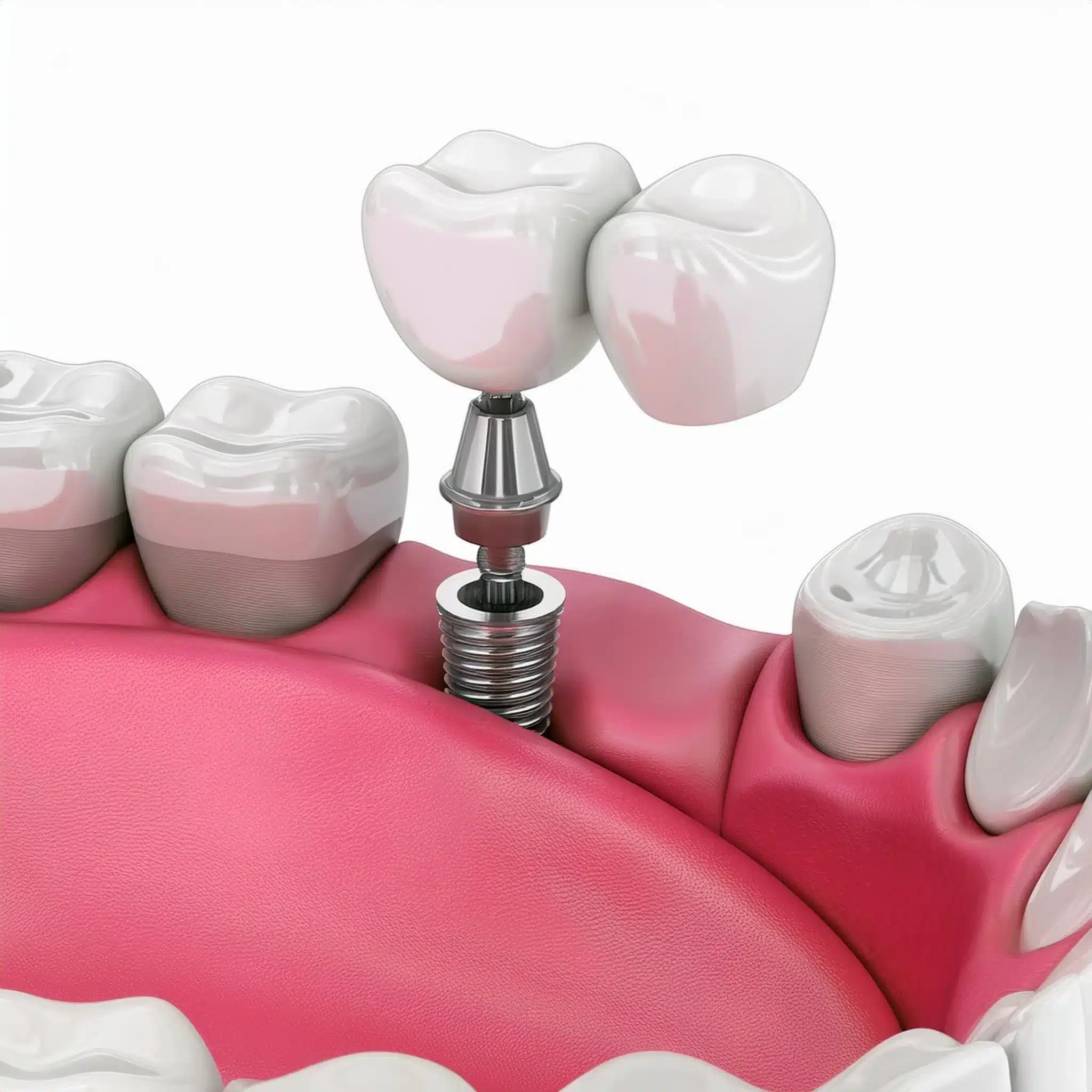Dental implant-supported bridges can be a life changer for those with missing teeth, but what are they and how do they work?
If you’re tired of uncomfortable dentures or bridges that don’t fit quite right, you’re probably wondering if dental implant-supported bridges are the answer you’ve been looking for.
What are implant-supported bridges?
Implant-supported bridges are a type of dental restoration that uses dental implants to support a bridge, a solid solution for missing teeth.
With a 92.3% success rate (1), they offer better aesthetics, functionality and durability, making them a popular choice for those looking for a long-term solution.

Types of Dental Implant-Supported Bridges
Fixed Implant-Supported Bridges
Fixed implant-supported bridges are a type of dental implant-supported bridge that is permanently attached to the jawbone.
This type of dental bridge is suitable for patients with sufficient bone density who are looking for a long-term solution for missing teeth.
According to a study in the Journal of Clinical Oral Implants Research, fixed implant-supported bridges have a 97.3% success rate over 5 years (4).
Removable Implant Supported Bridges
Removable implant supported bridges are designed to be removable by the patient.
This type of dental bridge is suitable for patients with limited bone density or looking for a more affordable solution for missing teeth.
A study in the Journal of Prosthetic Dentistry found that removable implant-supported bridges can improve patient satisfaction and quality of life (5).
| Type of Bridge | Description |
|---|---|
| Fixed Implant Supported Bridges | A fixed bridge attached to dental implants, providing a stable and durable solution for missing teeth. |
| Removable Implant Supported Bridges | A removable bridge attached to dental implants, providing a convenient and comfortable solution for missing teeth. |
Benefits of Dental Implant-Supported Bridges
Aesthetics
Dental implant-supported bridges can improve your smile.
With a 90–95% success rate over 10 years (2), they are a long-term solution for missing teeth.
The implants are designed to look and feel like your natural teeth, so it’s hard for others to notice you have an implant.
Functionality
Dental implant-supported bridges can also improve the functionality of your teeth.
Unlike traditional dentures or bridges, which can slip or fall out, dental implant-supported bridges are attached to the jawbone.
So you can eat, speak, and do daily activities with confidence.
In fact, studies have shown that dental implants can improve chewing efficiency by up to 90% (3).
Durability and Longevity
Dental implant-supported bridges are designed to last for many years.
With proper care and maintenance, they can last up to 20–30 years or more (2), so they are a cost-effective solution for missing teeth as they can reduce future dental work.
| Benefits | Description | Statistics |
|---|---|---|
| Improved Aesthetics | Dental implant supported bridges can improve the appearance of your smile. | 92.3% success rate (1) |
| Improved Functionality | Dental implant supported bridges can improve the functionality of your teeth. | 90-95% success rate over a 10-year period (2) |
| Durability and Longevity | Dental implant supported bridges can last for 20-30 years or more. | 20-30 year average lifespan (2) |
| Success Rate | Dental implant supported bridges have a high success rate. | 92.3% success rate (1) |
How do dental implant-supported bridges work?
Dental implant-supported bridges work by using dental implants to support a bridge, a solid solution for missing teeth.
The most common type used are endosteal dental implants, which are designed to mimic the natural roots of teeth and are made of titanium, a biocompatible material that is strong and durable
The implants are designed to mimic the natural roots of teeth and are made of titanium, a biocompatible material that is strong and durable (6).
The Procedure for Dental Implant-Supported Bridges
The procedure for dental implant-supported bridges involves:
Consultation and planning: First, you need to consult with a dentist or oral surgeon to see if dental implant-supported bridges are suitable for you.
Implant placement: Next, the implants are placed in the jawbone. This is done under local anesthesia and takes about 1-2 hours.
Healing: After the implants are placed, the jawbone needs to heal and integrate with the implants. This can take several months.
Bridge placement: Once the implants have healed, the dental bridge can be placed on top of the implants.
A study in the Journal of Oral Implantology found the success rate of dental implant-supported bridges is 95% over 5 years (7) so they are a tried and tested solution for missing teeth.

Who is a good candidate for Dental implant-supported bridges?
Dental implant-supported bridges are a viable treatment option for patients with missing teeth, but who is a good candidate for this procedure?
According to a study in the Journal of Clinical Oral Implants Research, patients with sufficient bone density and good overall health are ideal candidates for dental implant-supported bridges (6).
Considerations
When considering implant-supported dental bridges, you need to take into account:
Number and location of missing teeth
Condition of the surrounding teeth and gums
Patient’s overall health and medical history
Patient’s lifestyle and habits ( smoking, grinding or clenching teeth)
A study in the Journal of Prosthetic Dentistry found patients with a history of periodontal disease or tooth decay may be at higher risk for complications with dental implant-supported bridges (7).

What should I expect during the procedure?
Dental implant-supported bridges are a complex procedure that requires careful planning and execution.
According to a study in the Journal of Oral Implantology, the procedure involves several stages: consultation, planning, implant placement and bridge placement (4).
Pre-Procedure Preparation
Before the procedure, patients will typically undergo a thorough examination and consultation with their dentist or oral surgeon.
This will include a review of their medical history, a thorough examination of their teeth and gums, and a discussion of their treatment options.
According to a study in the Journal of Clinical Oral Implants Research, patients with a history of periodontal disease or tooth decay may need additional treatment before having dental implant-supported bridge placement (5).
The Procedure
The procedure starts with the placement of the implants.
This is done under local anesthesia and takes about 1–2 hours.
According to a study in the Journal of Prosthetic Dentistry, implants are placed in the jawbone at an angle of 30–40 degrees to maximize stability and support (1).

Conclusion & Key-Takeaways
Key Takeaways:
Dental implant-supported bridges are a tried-and-tested solution for missing teeth.
They offer better aesthetics, functionality, and durability than traditional dentures or bridges.
The success rate of dental implant-supported bridges is high, up to 98% over 10 years (4).
Conclusion:
Dental implant-supported bridges are a popular solution for missing teeth.
With their high success rate and long-term durability, they are a tried-and-tested option for patients looking to restore their smile and improve their oral health.

FAQ
References
Esposito M, et al. Interventions for replacing missing teeth: different types of dental implants. Cochrane Database Syst Rev. 2014;(7):CD003815.
Article: Interventions for replacing missing teeth: different types of dental implants
Albrektsson T, et al. Dental implants—are they better than natural teeth? Eur J Oral Sci. 2018;126(3):227-236.
Article: Dental implants—are they better than natural teeth?
Bhatnagar VM, et al. Dental implants: A review. J Clin Diagn Res. 2016;10(9):ZE01-ZE04.
Article: Dental implants: A review
ScienceDirect Topics. Dental Implant: An Overview.
Article: Dental Implant: An an Overview
Esposito M, et al. Dental implants: A systematic review. Eur J Oral Implantol. 2017;10(2):153-164.
Article: Dental implants: A systematic review
JAMA Network. With Dental Osseointegrated Implants.
Article: With Dental Osseointegrated Implants
Scopus. Placement of dental implants in the maxillary tuberosity: a systematic review.
Article: Placement of dental implants in the maxillary tuberosity: a systematic review




